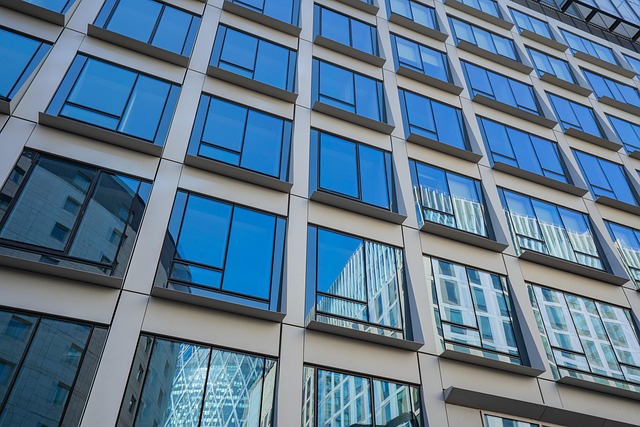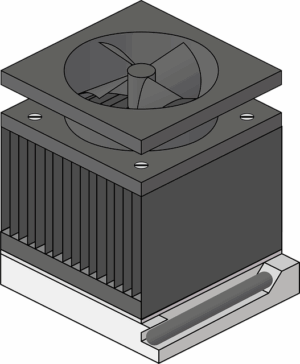Commercial air doors optimize space in older buildings with unique architecture by maintaining climate control, energy efficiency, and indoor air quality while managing traffic flow at entrances. Their compact designs accommodate limited overhead clearance, enhancing building performance and reducing energy costs for warehouses, retail stores, and industrial facilities. Heated air doors and HVAC air curtains offer advanced climate control solutions, making them key strategies in today's competitive business environment.
In many commercial settings, overhead space is at a premium. Traditional swinging or sliding doors can be cumbersome, taking up valuable room and impeding workflow. Low-profile commercial air doors offer an innovative solution for optimized space utilization without compromising functionality. This article explores the critical role of commercial air doors in managing limited overhead space, delving into design features, benefits across various applications, and essential installation and maintenance considerations.
- Understanding Space Constraints in Commercial Settings
- The Role of Air Doors in Space Optimization
- Design Features for Low-Profile Air Doors
- Benefits and Applications in Limited Overhead Environments
- Installation and Maintenance Considerations
Understanding Space Constraints in Commercial Settings

In commercial settings, space optimization is a key challenge, especially in older buildings or those with unique architectural designs. Understanding and accounting for overhead space limitations is crucial when selecting any equipment, including entrance solutions like commercial air doors. These doors play a vital role in maintaining climate control, energy efficiency, and indoor air quality while managing traffic flow at entrances.
Commercial air doors, also known as entrance air barriers or HVAC air curtains, offer advanced technology to address these issues. Their compact designs ensure they can be installed in spaces with restricted overhead clearance, making them suitable for warehouses, retail stores, and industrial facilities. Unlike traditional door systems, energy-efficient barriers provide a seamless transition while controlling the flow of heated or cooled air, thereby enhancing overall building performance.
The Role of Air Doors in Space Optimization

In today’s dynamic commercial landscape, space optimization is key to enhancing efficiency and productivity. Commercial air doors play a pivotal role in achieving this by offering innovative solutions for entrance and climate control. These doors act as versatile entrance air barriers, providing an effective barrier against unwanted drafts, temperature fluctuations, and even noise pollution. By integrating advanced technologies like heated air doors or energy-efficient HVAC air curtains, businesses can ensure optimal comfort and air quality within their facilities.
For warehouses, retail stores, and industrial settings with limited overhead space, low-profile commercial air doors are particularly beneficial. These door systems, designed to be both compact and efficient, allow for seamless navigation while maintaining a controlled internal climate. Whether it’s managing temperature in a heated warehouse or minimizing energy loss in a retail store, the strategic deployment of commercial air doors represents an intelligent step towards sustainable and optimized operations.
Design Features for Low-Profile Air Doors

Low-profile commercial air doors are designed with specific considerations in mind to accommodate limited overhead space. These doors prioritize a sleek and compact design, often featuring minimalist frames and streamlined components, ensuring they take up minimal vertical real estate. This is particularly beneficial in spaces where headroom is restricted, such as lower ceilings or narrow corridors.
Key design features include adjustable height settings, allowing for customization to fit various applications. Some models employ advanced sealing mechanisms to create an effective entrance air barrier, preventing the infiltration of external elements like dust, pests, and weather conditions. Additionally, energy-efficient options are available, incorporating technologies like heated air doors or HVAC air curtains to maintain climate control while minimizing energy consumption, making them ideal for industrial entrance solutions, retail environments, and warehouse door heating applications.
Benefits and Applications in Limited Overhead Environments

Low-profile commercial air doors offer a range of benefits in environments with limited overhead space. These advanced entrance solutions act as both robust and energy-efficient barriers, providing effective climate control and ensuring optimal conditions within buildings. By using heated air doors or HVAC air curtains, businesses can maintain comfortable indoor temperatures while minimizing energy consumption, making them ideal for warehouses, retail stores, and industrial facilities with high traffic and specific environmental requirements.
Commercial air doors are versatile and can be tailored to meet various needs. They serve as entrance air barriers, preventing the loss of conditioned air and maintaining indoor air quality. Moreover, their compact design allows for easy installation in spaces where traditional commercial door systems would not fit, making them a game-changer for those seeking innovative industrial entrance solutions.
Installation and Maintenance Considerations

The successful installation and ongoing maintenance of low-profile commercial air doors are key to ensuring optimal performance in limited overhead spaces. Proper placement is crucial; these doors must create a tight seal against the frame to prevent energy loss and maintain desired climate control. During installation, consider factors like existing hardware compatibility, floor strength, and necessary adjustments for seamless integration into the existing building infrastructure.
Regular maintenance, including cleaning, lubrication of moving parts, and inspection for signs of wear or damage, is essential for longevity. Many commercial air door systems incorporate energy-efficient features such as heated air curtains or HVAC air curtains to counteract temperature loss, making them suitable for industrial entrance solutions, retail environments, and warehouse applications. Choosing the right commercial door system, like entrance air barriers or climate control doors, will not only optimize energy efficiency but also enhance overall building performance through advanced commercial entrance technology.
Commercial air doors offer a versatile solution for optimizing limited overhead space in various business settings. Their design features, tailored for low-profile installations, enhance functionality while ensuring aesthetic appeal. These doors not only improve energy efficiency but also provide easy access and enhanced safety in environments with restricted height. By considering the benefits outlined in this article, businesses can make informed decisions when selecting commercial air doors suitable for their unique overhead space challenges.






